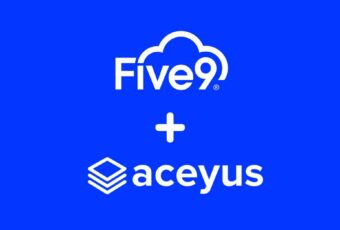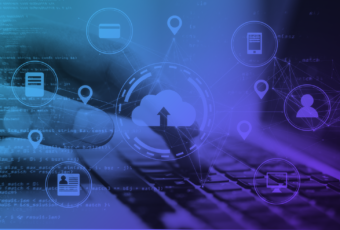Hello. In an earlier blog post, we explained our approach to creating software solutions that help our customers use data for the greater good. We constantly generate ideas to create relevant and practical solutions that enhance the customer experience. Today, we make a significant announcement: Aceyus has created a data integration solution for Aceyus VUE that enables real-time tracking and measures essential metrics for Intelligent Virtual Agents (IVA).
A Real-Time View of an IVA’s Effectiveness
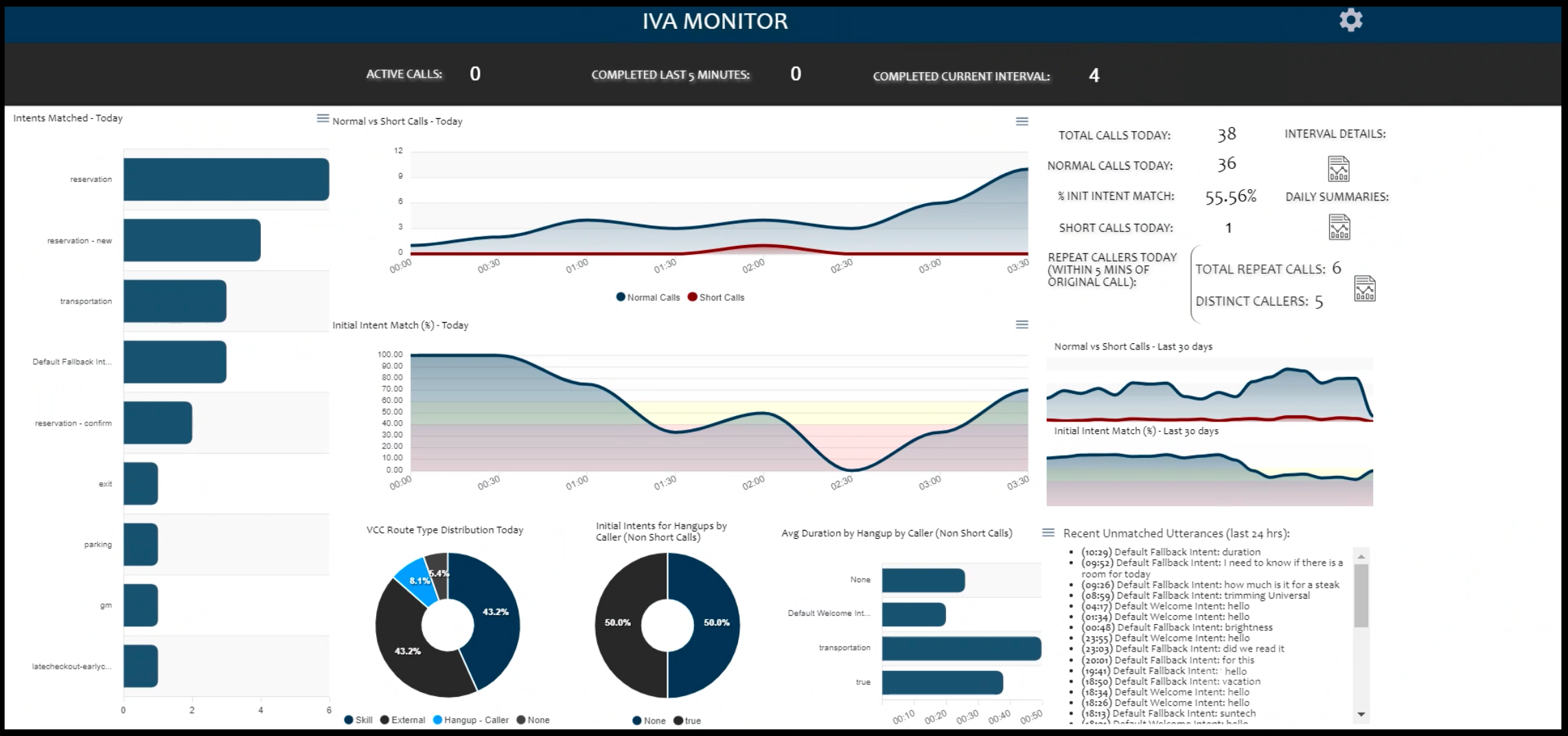
This new data integration, incorporated into the Aceyus VUE platform, creates insights that help customers fine-tune IVA responses and call flow to a perfect pitch. As a result, customers can stay up to date on their IVA performances across various regions and lines of business. We’ll break it all down for you in this blog.
The data that Aceyus VUE provides helps businesses measure IVA effectiveness and reduces this type of occurrence:
Anatomy of an Example “Short Call.”
“Hello, your call is important to us. In a few words, please tell us how we can help you. For example, if you want to check a reservation, say “reservations.”
“What time can I check in?”
“I’m sorry, I did not get that.”
“Is my room ready yet?”
“I’m sorry, I did not get that.”
*DISCONNECTS*
Where Were the Programmed Intents?
All IVAs have a list of programmed intents that relate to a given business. For example, let’s use the hospitality industry. It has a list of common intents—the services that callers request. They can include “reservations,” “transportation,” and “parking.” Our IVA data integration helps to identify caller intent.
We measure how many times the IVA matched caller intent to what the caller actually said. (Left side of the above chart).
What the caller said is an utterance. As we’ve already seen, the IVA doesn’t always “understand” caller intent, because it’s not yet “learned” what a caller means by a given utterance.
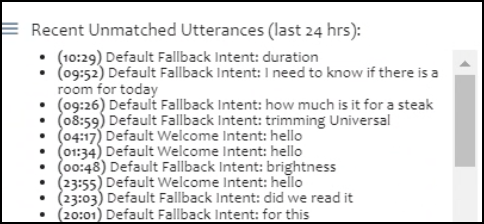
This chart above identifies utterances that remain presently unmatched by the IVA. When an IVA doesn’t yet match what callers say to whatever a business offers as intents, oftentimes they become frustrated and may even hang up.
Interval Reports Summarize an IVA’s Effectiveness
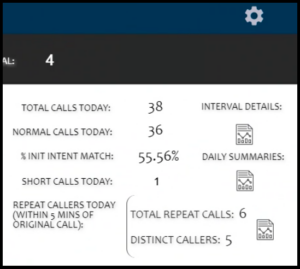
Most of these metrics are self-evident. Others, perhaps not. For example: “Short Calls” last less than 15 seconds and end with a customer hang up. The likely cause of this single short call: The IVA didn’t “understand” the caller’s utterance because it doesn’t exist (yet) in the IVA’s algorithm.
Another important bit of data is “Repeat Callers”, which may also indicate that the IVA did not match the utterance to the intent.
We said in an earlier blog that IVAs can start out like toddlers: they need instruction to progress and mature. To achieve this, an IVA needs extensive learning to understand questions common to each business. Specifically, it needs to learn to recognize and associate an unfamiliar utterance to an existing intent. Only then can it respond with specific and accurate information to each query.
“When is the Next Shuttle?”
For example, if a business lists “transportation” as a caller intent. If a caller says, “When is the next shuttle?”, the IVA may not understand the intent, which is clearly transportation. However, because the IVA Monitor captures that utterance, our customer can adjust the IVA algorithm to match “When is the next shuttle?” (and other variations) to the intent of “transportation.”
And when the time comes for our hypothetical hospitality chain to adjust an IVA algorithm, they can easily monitor and measure the changes to ensure that the changes are successful.
Now, “listen” to our earlier example, with adjusted algorithms:
“Hello, your call is important to us. In a few words, please tell us how we can help you. For example, if you want to check a reservation, say “reservations.”
“What time can I check in?”
“Check in is at three o’clock p.m. If you need more information, please press, or say, “one.”
OR
“Is my room ready yet?”
“Let me get some more information from you. What is your name, please?”
“Joseph Weizenbaum.”
“Thank you. Let me check on that.”
Ideally, the IVA itself will address and solve the caller’s intent without routing the call to a live agent. Bottom line: We possess knowledge of whether the IVA successfully aligned with the caller’s primary and secondary intentions as well as the subsequent course of action. Was the customer adequately assisted by the IVA? Did it direct them to a call center agent or the appropriate business location? And most importantly, was this response the correct one? Aceyus VUE data offers precise identification of the entire interaction between a caller and your IVA, revealing the exact occurrences.
In a phrase we like to use: “We turn on the lights” to illuminate a contact center’s actual effectiveness.
By Revealing Detailed Data Like This:
This Sankey chart maps IVA calls from Initial Intent to Last Intent, to Route Destination. Study it for a second before you read on. (You may need to enlarge the image, but it’s worth the effort.) The width of the path indicates volume of calls for a corresponding intent: wider = more. To trace a specific pathway, begin on the right side of the chart, under the heading “IVA Pathways.”
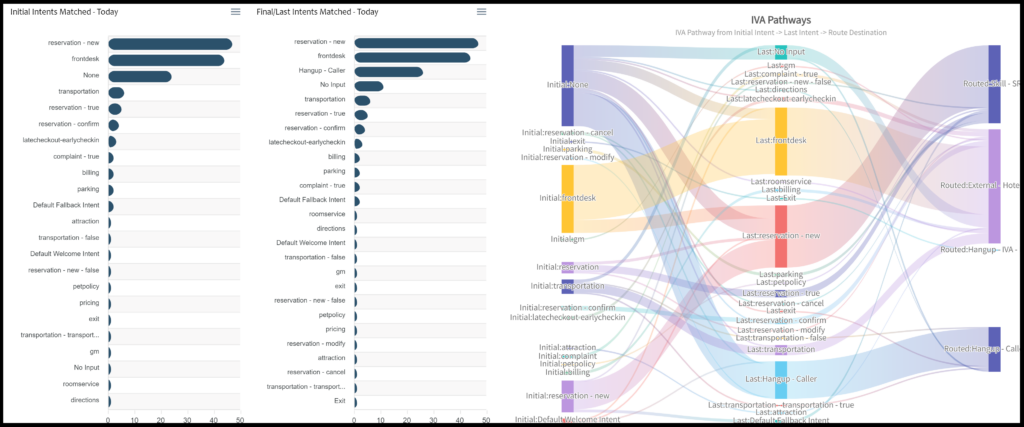
A quick global glance indicates that most of the “Initial – None” intents get routed to a live agent (“Routed Skill – SRS”) or to the Hotel (“External – Hotel”). This is because the IVA offers the caller many opportunities to restate an intent that the IVA can possibly match, indicated in the “Last:” column in the center of the graph.
Another Example: “Initial: Front Desk.” Trace it to the “Last:” column. Notice that the bar splits and the lower bar is red. This indicates callers changed intent, in this case to “reservation – new”. The “new” intent altered the IVA path to “Routed Skill – SRS.”
The data integration also counts the number of initial intents and final intents that matched. This customer may want to examine, as an example, why the intent “reservation – confirm” matched so infrequently when compared to “reservation – new.” It is this level of detail that determines if the IVA is directing callers to the right resource. Only Aceyus provides this level of detail.
With these insights, our clients retrieve and analyze every interaction with their IVA and examine every IVA pathway with just a few clicks and make any needed adjustments to increase the percentage of Intents Matched. To reiterate: Aceyus developed an exclusive integration that keeps track of IVA metrics like these, and a lot more. And it’s not an API; VUE integrates data directly from the IVA.
This List Summarizes What our IVA Data Integration Tracks and Measures in Real Time
- Active Calls
- Calls Completed in Last 5 Minutes
- Completed: Current Interval
- Initial Caller Intent: Matched By Day
- Initial Caller Intent: % in Real Time
- Normal Calls by Day
- Short Calls by Day
- Repeat Calls by Day (within 5 minutes of the original call)
- Distinct Repeat Callers by Day
- Normal vs. Short Callers: Rolling Average
- VCC Route: Type Distribution
- Initial Intent: Caller Hang Ups (Non-Short Calls)
- Average Duration: Caller Hang Ups (Non-Short Calls)
- Recent Unmatched Utterances
- Interval Details
- Daily Summaries
Call Flow Visualization
Aceyus also offers Call Flow Visualization, which displays the number of calls that hit a given node for a specific script. It’s another valuable snapshot that shows the actual path of callers within a script and shows the impact of a specific intent. This instantaneous feedback directs businesses to lead customers on the short path to resolution.
To summarize: Aceyus has developed a data-driven solution that displays the metrics needed to fine-tune an IVA’s algorithm in real time.
With this data and insight, businesses tune their IVAs to match customer intent. Result: A call flow with few if any diversions or dead ends. Now, callers are no longer herded; they are heard, and helped. What about yours?
Contact us today to learn more about how our exclusive data integration can help optimize your contact center IVA.

